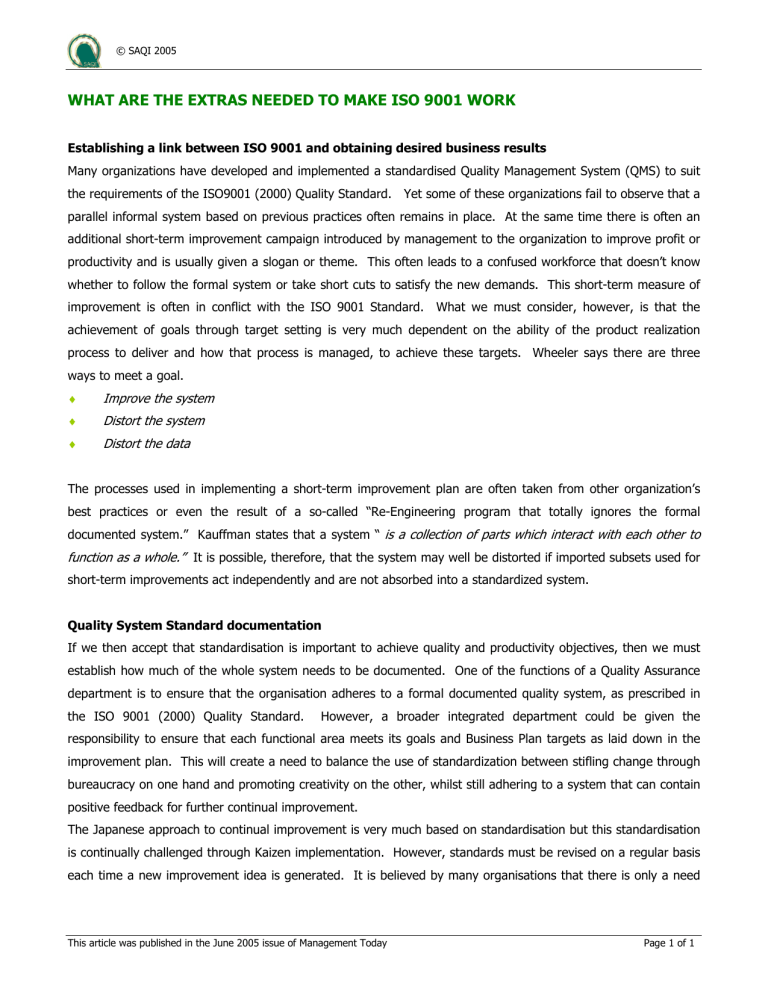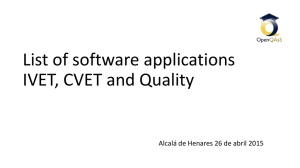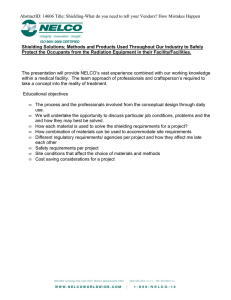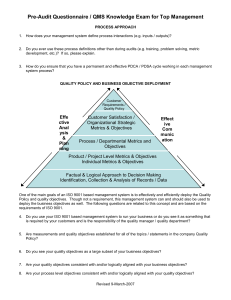WHAT ARE THE EXTRAS NEEDED TO MAKE ISO 9001 WORK

© SAQI 2005
WHAT ARE THE EXTRAS NEEDED TO MAKE ISO 9001 WORK
Establishing a link between ISO 9001 and obtaining desired business results
Many organizations have developed and implemented a standardised Quality Management System (QMS) to suit the requirements of the ISO9001 (2000) Quality Standard. Yet some of these organizations fail to observe that a parallel informal system based on previous practices often remains in place. At the same time there is often an additional short-term improvement campaign introduced by management to the organization to improve profit or productivity and is usually given a slogan or theme. This often leads to a confused workforce that doesn’t know whether to follow the formal system or take short cuts to satisfy the new demands. This short-term measure of improvement is often in conflict with the ISO 9001 Standard. What we must consider, however, is that the achievement of goals through target setting is very much dependent on the ability of the product realization process to deliver and how that process is managed, to achieve these targets. Wheeler says there are three ways to meet a goal.
♦
♦
Improve the system
Distort the system
Distort the data
♦
The processes used in implementing a short-term improvement plan are often taken from other organization’s best practices or even the result of a so-called “Re-Engineering program that totally ignores the formal documented system.” Kauffman states that a system “
is a collection of parts which interact with each other to function as a whole.”
It is possible, therefore, that the system may well be distorted if imported subsets used for short-term improvements act independently and are not absorbed into a standardized system.
Quality System Standard documentation
If we then accept that standardisation is important to achieve quality and productivity objectives, then we must establish how much of the whole system needs to be documented. One of the functions of a Quality Assurance department is to ensure that the organisation adheres to a formal documented quality system, as prescribed in the ISO 9001 (2000) Quality Standard. However, a broader integrated department could be given the responsibility to ensure that each functional area meets its goals and Business Plan targets as laid down in the improvement plan. This will create a need to balance the use of standardization between stifling change through bureaucracy on one hand and promoting creativity on the other, whilst still adhering to a system that can contain positive feedback for further continual improvement.
The Japanese approach to continual improvement is very much based on standardisation but this standardisation is continually challenged through Kaizen implementation. However, standards must be revised on a regular basis each time a new improvement idea is generated. It is believed by many organisations that there is only a need
This article was published in the June 2005 issue of Management Today Page 1 of 1
© SAQI 2005 to document basic quality related processes when developing a formal system and other activities such as cost reduction or business improvement have no place for standards. Dale in his book Managing Quality refers to these as
‘Level One Uncommitted Companies’
.
The old ISO 9001 (1994) Standard has in the past led to a stagnation of Quality Management Systems because of the lack of a specific clause requiring the continual improvement of the formal system. This situation was exacerbated because the main reason for introducing ISO 9001(1994) by many organisations was to stay on a customer’s preferred supplier list, rather than use it as an improvement tool.
This situation should have been rectified with the introduction of the updated ISO 9001 (2000) Standard that requires that ongoing improvement be in place. This revised version of ISO 9001 follows the application of the
Shewhart PDCA cycle and is an attempt to align the Standard to suit market requirements and focuses on the continual improvement of the Quality management system to improve Customer Satisfaction. So in fact there should be no need for a separate short-term improvement campaign as this is actually an admission that the formal Quality Management System has failed. It is unfortunate that the emphasis is put on the words Quality
Management System because this often detracts senior executives from becoming involved in the realization process as they see ISO 9001 as only addressing the activities carried out in the QA department.
The role of communication
If the introduction of standardisation and setting a common goal is to improve performance results then the content of these standards and the focused goal must be communicated to the entire workforce. Peter Wickens in his “Road to Nissan” cites six paragraphs from the Industrial Society’s (UK) “Charter for People at Work” which are stated as follows:
♦
The greatest challenge is co-operating with change – both technical and structural. All change must be supported by effective leadership from those accountable for involving people at every level.
♦
♦
♦
♦
♦
Views of people at work should be consistently sought and taken into account by management.
To gain flexibility, commitment and the highest level of customer satisfaction and a sense of achievement we need to explain decisions and relevant business issues at regular intervals.
We should take the lead in providing opportunities for individuals to contribute in the most appropriate way. Industry and commerce must in turn contribute to the community if it is to provide employment, resources and hope for the future.
Individuals should be encouraged to participate fully in the activities of their trade union. Productive management – union relations should include the positive commitment from both parties to the aims and success of the enterprise and to the achievement of justice for the people involved.
We should work to ensure that the whole community, especially the young, understands why the creation of wealth matters, both for future employment and for society as a whole.
This article was published in the June 2005 issue of Management Today Page 2 of 2
© SAQI 2005
Peter Wickens goes on to say that ‘
if such philosophical statements are to be true to themselves then the team should develop them.’
The Japanese see this communication role as important and have created various forums to discuss and display results and communicate improvement activities. These communication forums take place from green areas at shop floor level to Operations meetings at senior executive level.
Improvement plan interrelationships across divisions
Each division has an interrelationship in the formal system with all the others. This series of interrelationships is depicted in Figure 1.2 System Thinking Interrelationships, where it can be seen that each part interacts with other parts to contribute to the whole system.
Figure 1 System Thinking Interrelationships
IN T E R R E L A T IO N S H I P S P A R T S
W H O L E
The above Figure shows a number of parts interacting with each other to form a whole system. In the case of larger organizations these parts illustrate the departments or divisions or even various tasks, processes or business plan targets that cut across divisions. The integrated Quality Management System attempts to bring these divisions together by bridging the silos that have often been allowed to flourish in the informal system. The
Japanese, however, take a different view and look at the whole system and rely on the individual management to ensure a harmonious approach. So facilitation must be extended to the way business is modified through changes to the system as well the achievement of new goals and targets as required in each Business Plan update set to improve the bottom line result. Corrective and preventive actions can then be determined which can be implemented in such a way as to keep the goals and objectives of all the divisions viable and still meet the collective targets of the organisation as a whole without adversely affecting the effectiveness of the Quality
Management System.
We therefore need a focused approach by all levels in the company to bring the operating system under control by the application of the standard way of daily management.
This article was published in the June 2005 issue of Management Today Page 3 of 3
© SAQI 2005
At shop floor level, once the operating system is under control, improvements can be made through Kaizen or gradual small improvements. Deming stated that the prevailing style of management must undergo transformation and that a system cannot understand itself. This transformation of management is necessary in order for the QMS to work effectively across all functions.
Management needs to understand the broad principles of the formal system as well as the informal system. Management Review cannot report that the ISO 9001 application is working well and in place if the data being reported indicates something different. Each manager needs to know whether his function is operating effectively within the broad system requirements of the QMS.
At shop floor level this is difficult to understand. To the operator the system is usually limited to the immediate task that is being performed in line with the Standard Operation Sheet. Just as the operators have little knowledge of the broader environment in which they work, management also have little knowledge of the total environment of each operator. If management do not understand the total process they cannot understand the variation emanating from that process.
Conclusion
We need an integrated approach to improve quality, productivity, profit and customer satisfaction. The basis for enabling the system appears to be twofold. Firstly it relies on a standardised approach and discipline must be in place to consistently work to and continually improve those standards, which form the basis of the system. The system needs to be reasonably prescriptive in its methods and application criteria and far more comprehensive than the basic requirements of the ISO 9001 (2000) version of a Quality Management Standard. The revised version of ISO 9001 has acknowledged that a broader view must be taken of a Management system by adding an improvement clause and by doing this has moved it closer to the customer requirements. Secondly the integrated system should cover all the human resource and softer issues that Wickens says must be in place prior to introducing an improvement philosophy. The broad system should support the empowerment principles of WE
Deming described in his work “Out of the Crisis”. It should also rely on a motivated and knowledgeable workforce that is prepared to work in a disciplined and harmonious manner. The system must be supported by all lower management and foreman who are able to play a leadership role in ensuring that senior management’s targets are met and at the same time ensure that the workforce are
willingly
working towards improvement goals. If the integrated system is used in its complete form, incorporating the application of all of the relevant standards, it can be used for achieving an improved bottom line result and eliminate the need for short term improvement campaigns. The downside of the described integrated approach is that it relies heavily on the selfdiscipline of each function to work to a standardised and harmonious method which comes naturally to the
Japanese but not so to the average South African.
This article was published in the June 2005 issue of Management Today Page 4 of 4
© SAQI 2005
Paul Harding is the sole proprietor of TriQ Co-operation Business Development and can be contacted at triqc@tiscali.co.za; website wwwtriq.co.za
This article was published in the June 2005 issue of Management Today Page 5 of 5





